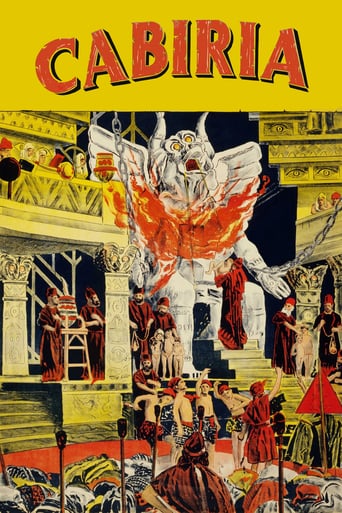Hellen
I like the storyline of this show,it attract me so much
Matcollis
This Movie Can Only Be Described With One Word.
StunnaKrypto
Self-important, over-dramatic, uninspired.
Taraparain
Tells a fascinating and unsettling true story, and does so well, without pretending to have all the answers.
Richard Chatten
Without Gabriele D'Annunzio's florid commentary this film would have been substantially shorter, while the hammy "silent film" acting and melodramatic storytelling lags far behind Scandinavian cinema of this period. But technically this super-production from Italy otherwise blazes a colossal trail that plainly led the way for the silent spectacles of Griffith, DeMille and Lang, while the sense of fun of the action scenes (particularly a scene depicting the formation of a human pyramid to scale a wall) anticipates Fairbanks at his jauntiest. Beginning with the eruption of Mount Etna (and a lot of toppling pillars) the pace never lets up. Next comes a truly hair-raising scene depicting infants cast into the flaming maw of a statue of Moloch (whose Temple - with three round windows that make it's façade resemble the face of an enormous spider - is one of the many deliriously stylised designs that obviously inspired the German historical epics of Lang and others during the early twenties); while later we see Archimedes gleefully incinerating the Roman fleet with history's first death ray during the Siege of Syracuse. Throw in the boisterous crowd scenes and graceful tracking shots director Pastrone innovatively employs throughout (far more elegant than Griffith's work of the same period) and we have the template for the historical epic as it existed for the next half-century.'Cabiria' also marks a major advance in the use of special effects that marks a decisive break with the trick films of Georges Méliès. Skillful use is made throughout of double exposures to make the action and the locations look even grander in scale than they already are (such as Hannibal crossing the Alps). And there is an additional bonus in the form of an extraordinary dream sequence that anticipates by ten years Walter Ruttmann's 'Falkentraum' sequence in Lang's 'Die Nibelungen'.
gavin6942
Three centuries before Christus. Young Cabiria is kidnapped by some pirates during one eruption of the Etna. She is sold as a slave in Carthage, and as she is just going to be sacrificed to god Moloch, Cabiria is rescued by both Fulvio Axilla, a Roman noble, and his giant slave Maciste.According to Martin Scorsese, in this work Pastrone invented the epic movie and deserves credit for many of the innovations often attributed to D.W. Griffith and Cecil B. DeMille. Among those was the extensive use of a moving camera, thus freeing the feature-length narrative film from "static gaze". Now, I prefer to think of the "moving camera" as a German invention, but I would be more than happy to grant Pastrone the epic.The film also marked the debut of the Maciste character, who went on to have a long career in Italian sword and sandal films. This is actually one of the most impressive cultural achievements, because the character Maciste became really has very little to do with this film. Whole studies could be done on how Maciste evolved.
Jamie Ward
There's something magical and alluring about Cabiria that goes above and beyond the sum of its hit-and-miss elements. Beautifully sprawling sets depicting ancient times with stunning detail and imagination serve as the backdrop to characters that jump out from the screen in a way that had yet been achieved anywhere else. In more ways than one, Cabiria strikes many a resemblance to Dante's Inferno from a few years prior, but tops said film on just about every count. Perhaps the most vivid comparison between the two lies in its special effects. While Inferno's imagery strived for biblical grandeur, Cabiria instead delivers something that's more artistic and frail. Sure, there are scenes which focus mostly on disaster and action, but it's the movie's dabbling in dream-like effects and romantic imagery that gives it the upper hand. By no means is everything perfect, however. It has to be said that moments of banality and obtuse, incomprehensible plotting occur more frequently in between moments that either awe you with spectacle or woo you with charm. Nevertheless, the film still manages to make its mark well, standing out vividly from its early cinematic siblings thanks to its more straight-forward subplots which more often than not cease any yawns beginning to surface. Perhaps most staggering of all is the film's scope, not just in ambition and bravado, but in its ability to strike genuine pathos. Whether it's moments of comic relief, tragic despair or sheer thrill, Cabiria gripped me from time to time in ways that earlier features failed to do. Definitely worth at least one watch for curious cinephiles and in my opinion is the first truly worthwhile entry in cinema's awkward infancy years.
jazzest
The splendid set design back in 1914, which would obviously influence Griffith's Intolerance a few years later, is worth watching. Other than that, as a work in the dawn of film history, Cabiria inevitably suffers several flaws. Comprising exclusively medium and long shots (with absolutely no close-ups), the film should have relied on engaging storytelling, but it just progresses tediously. As a title role, Cabiria should have appeared on the screen more, but she serves as a catalyst and stays behind the scene for most time.Versatile solo piano on the soundtrack (which is, according to the credit of "1990 alternate version" I watched, "Piano Score recorded by Jacques Ganthier, based on the original 1914 score," which I assume is composed by Manlio Mazza) imitates Classical composers in various eras, from Bach to Beethoven to Schumann to Brahms to Debussy, and is quite enjoyable by itself.

